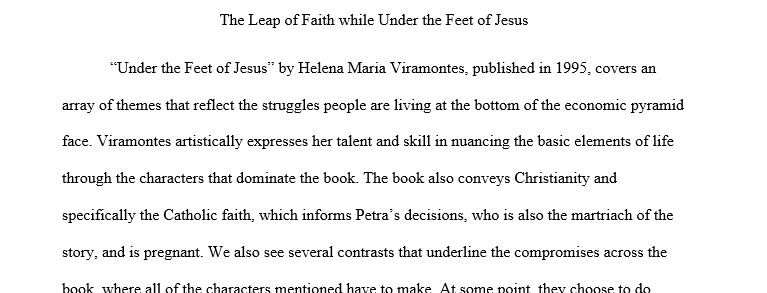Under The Feet of Jesus ends with several “cliffhangers”: We are never told, for instance, whether Alejo lives or dies, whether Perfecto
For this essay, you will write a 1,200 word response to one of the following questions regarding Helena María Viramontes’ novel, Under The Feet of Jesus:
1.) Under The Feet of Jesus ends with several “cliffhangers”: We are never told, for instance, whether Alejo lives or dies, whether Perfecto stays with the family or leaves, or whether the police come for Estrella. Why do you think Viramontes chose to end the novel on such an ambiguous note? How might the ambiguous ending reflect the larger themes or concerns of the novel? Are there any clues to indicate what events may have taken place following the final scene of the novel, when Estrella climbs onto the barn roof? (Note: When answering this question, you may focus either on the story arc of a single character or multiple characters.)
2.) Viramontes’ novel contains many iconic images of US consumer culture and popular culture, including the woman from the Sun Maid Raisin box, the Quaker Oats mascot, the Coca Cola bottle, the ARGO woman on a box of corn starch (31), cans of spam (110-112), and pictures of Marilyn Monroe and Elvis Presley (110, 153). Why do you think the novel repeatedly references consumer products and provides extended visual descriptions of these products? How might these iconic images, and Viramontes’ descriptions of them, help us to understand the experience of the characters and/or the larger message(s), themes, or concerns of the novel?
3.) The novel contains a great deal of religious – specifically, Catholic/Christian – imagery and allusions. For instance, the novel’s title, Under The Feet of Jesus, seems to refer to Petra’s statue of Jesucristo, beneath which the family’s birth certificates are kept (164-170). The novel also draws parallels between the character of Estrella, on the one hand, and Biblical figures such as Moses and Jesus, as in the final scenes of Chapter 4 (156) and Chapter 5 (175-176). Other references are made to Petra’s rosary beads (16-17) and the image of the Virgen de Guadalupe (110-112). Why do you think the novel relies so heavily on Catholic/Christian imagery and allusions when describing the lives and experiences of these characters? How might these images help us to understand the characters themselves and/or the larger message(s), themes, or concerns of the novel?
4.) The novel contains many vivid descriptions of physical spaces such as the barn, bungalow, and the surrounding land, the fields where Estrella, Petra, and Alejo work, the family’s apartment before Estrella’s father left (16-19), the store where Petra shops for groceries (108-114), the medical clinic where the family takes Alejo (Chapter 4), etc. Why do you think the writer gives so much attention to the physical details of the environments in which these characters live? How might the descriptions of the physical landscape(s) of the story help us to understand the emotional landscape(s) of the characters’ lives and/or the larger message(s), themes, or concerns of the novel?
Answer preview for Under The Feet of Jesus ends with several “cliffhangers”: We are never told, for instance, whether Alejo lives or dies, whether Perfecto

1478 Words